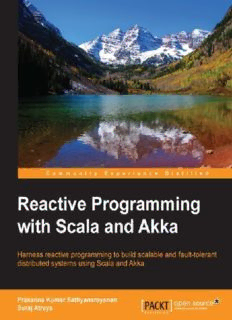
Reactive Programming with Scala and Akka PDF
Preview Reactive Programming with Scala and Akka
Table of Contents Reactive Programming with Scala and Akka Credits About the Authors About the Reviewers www.PacktPub.com eBooks, discount offers, and more Why subscribe? Preface What this book covers What you need for this book Who this book is for Conventions Reader feedback Customer support Downloading the example code Downloading the color images of this book Errata Piracy Questions 1. Introducing Reactive Programming Introduction The rise of the data age Tenets of reactive programming How do tenets blend together? An example use case Responsive Resilient / fault tolerant The respect failure deserves Scalable Storage scaling Compute scaling Message-driven Practices complementing reactive programming Functional programming Asynchronous programming Data streams Micro-services RESTful services Features of a RESTful service Representations Messages URIs Statelessness Caching Some technical use cases of reactive applications Internet of Things Reactive electricity measure Tumblr's architecture Tumblr's internal firehose Tools of the trade The Scala programming language Akka SBT A skeleton SBT project ScalaTest – a unit testing framework A word about IDEs Summary 2. Functional Reactive Programming in Scala Mutability versus immutability Collections List Map Set List transformations map flatMap filter Sort foldLeft foldRight Lazy val Function composition Functors, applicative functors, and monads The Scalaz dependency Functor Applicative functor Revisiting point and pure Monad Indexing files for searching Function composition revisited Ease of unit testing Summary 3. Asynchronous Programming in Scala Synchronous versus asynchronous programming Synchronous programming Asynchronous programming Futures Futures as concurrency abstraction Futures in Scala How Futures in Scala work Writing your first Future in Scala Understanding Futures in Scala Enter Promise Composing Futures Why nested Futures are hard Building an asynchronous client Implementing the service Implementing a client API for CoffeeShop Query for ShopMenu Placing an order with CoffeeShop Canceling an order Confirming an order Paying for an order Example – A simple data crawler using Futures About the dataset Structure of the dataset Goal A sample RSS XML file Data crawler workflow Implementation RSSReader Page crawler Wiring up and moving forward Summary 4. Akka for Reactive Programming Concurrency and parallelism Actor model Threads and actors An introduction to Akka Actor mailbox Actor systems Messaging passing Creating an actor system Creating an ActorRef Sending a PizzaRequest to the ActorRef Actor messages Mailbox Dispatcher Actor path The actor life cycle Deadletters Event streams Actor deathwatch Actor supervision Supervision strategies OneForOneStrategy The actor hierarchy PastaException The final state AllForOneStrategy The actor hierarchy PastaException The final state Summary 5. Building Resilient Application with Akka An introduction to actor routing Routers and routees Routing logic RoundRobin Strategy SmallestMailbox Strategy RandomRouting Strategy ScatterGatherFirstCompleted Strategy BroadCast Strategy Pizza delivery workflow implementation with actor routing PizzaShop actor workflow Taking the order Finding a chef to prepare the order Finding the oven to bake the pizza Concluding remarks Work pulling patterns Pizza workflow implementation with the work pulling pattern Actor mailbox Types of mailbox implementation Unbounded mailbox Bounded mailbox Unbounded priority and bounded priority mailbox Akka persistence Event sourcing Commands and events Actors and state Summary 6. Akka Cluster Introduction to Akka cluster Membership life cycle Elasticsearch RSS links using Akka cluster Adding nodes elastically Removing a node (or nodes) Elasticsearch indexing Setting up Elasticsearch Installing the Marvel plugin Elasticsearch client Implementation Master worker protocol Master WorkState Worker WorkExecutor Summary 7. Finite State Machines with Akka Introducing FSM Relation to actors Become/unbecome in actors Writing FSMs with actors FSM implementation Implementing FSM for a simple stock price average counter The problem statement The approach Implementation of FSM Init state → BurstAccept state BurstAccept state → CalcBurstValues state CalcBurstValues state → Init state BurstData BurstEnd SessionEnd All put together Generated output Extending further Concluding remarks The Agent service Creating agents Updating the value of an agent Reading a value from an agent Summary 8. Akka Unit Testing Introducing ScalaTest Setting up ScalaTest Setting up the test environment Our first ScalaTest code Matchers Types of matcher Simple value matchers String matchers Boolean operator matchers Reference matchers Compound matchers Property matchers Marking tests Asserting exceptions Putting everything together to test the pizza example A word about fixtures Other variants of ScalaTest WordSpec FeatureSpec FlatSpec IDE support Specs2 Setting Specs2 in SBT Rewriting the PizzaOrder example in Specs2 Testing Actors with ScalaTest Akka TestKit Testing Actors Testing FSM Summary 9. Distributed Systems and Key-Value Stores Distributed systems Scalability Latency Availability Partitioning of data Replication The consensus problem The CAP theorem Differences between CA and CP systems FLP impossibility result The importance of timing and order Timing in distributed systems Global clock Local clock No clock Lamport's algorithm Vector clock Consistency guarantees Eventually consistent system DynamoDB Conflict-Free Replicated Data Type (CRDT) Sets GSet (or growth-only set) ORSet (observed-removed set) Counters GCounters (growth-only counters) PNCounter (positive/negative counter) Maps ORMultiMap (observed removed map) A distributed in-memory key value store Summary Index Reactive Programming with Scala and Akka
Description: